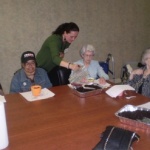 Thanks to the Beachwood Senior Center for inviting me to share “Making Lemonade From Lemons” with their members. I gave them tools for making the best out of a tough situation, and finding ways to be optimistic and happy. The participants were very optimistic about the new tips they learned 🙂
Thanks to the Beachwood Senior Center for inviting me to share “Making Lemonade From Lemons” with their members. I gave them tools for making the best out of a tough situation, and finding ways to be optimistic and happy. The participants were very optimistic about the new tips they learned 🙂
4/14/14 – Journalism Class at the East Cleveland City Hall
4/9/14 – Container Gardening Class
 Lots of enthusiasm at Northfield Village Nursing and Rehab Center today! Folks from the local senior center joined us for a Container Gardening class. We discussed lots of tips to make gardening easier, as well as design guidelines for creating beautiful plater arrangements. Everyone was so glad it’s finally Spring!
Lots of enthusiasm at Northfield Village Nursing and Rehab Center today! Folks from the local senior center joined us for a Container Gardening class. We discussed lots of tips to make gardening easier, as well as design guidelines for creating beautiful plater arrangements. Everyone was so glad it’s finally Spring!
4/3/14 – Perfect Songs to Welcome Spring!
Healthy cooking for older adults
Older couples and single people living on their own often have trouble making nutritious meals for themselves. Understanding nutritional needs and appropriate calorie intake can be confusing. Fresh ingredients are frequently sold in packages that are too large to finish before they go bad. Eating healthfully can also cost more, and the time required to cook sometimes doesn’t seem worth the effort. Following are some tips to help you eat in a healthy way without a lot of effort.
In 2011, the USDA updated the Food Pyramid of healthy eating guidelines and created a new initiative called Healthy Plate. The guidelines are based on the USDA publication “2010 Dietary Guidelines for Americans” (DGA), and have been revised to make it easier to make better food choices. The guidelines suggest how to balance calories; add more healthy foods, such as fruits, vegetables and whole grains, to your diet; and decrease the amount of unhealthy foods, such as those with high-sugar and high-sodium ingredients.
Appendix 6 in the DGA outlines the number of calories per day that one needs based on age, gender and level of activity. Appendix 7 describes the five basic food groups, and the number of servings from each group a person needs for his or her target calorie intake. By following these guidelines, you will automatically take in the appropriate amount and variety of nutrients your body needs.
One easy way to eat the recommended servings of fresh vegetables, and finish them before they go bad, is to cut several servings of various vegetables into bite-size pieces and store them in plastic containers. You can then quickly add them to soups, salads and other dishes. You can also steam vegetables and add them to baked potatoes, rice and pasta; or eat them as a side dish.
Some leftover fruits and vegetables can be frozen and preserved for later use. Muffins and breads also freeze well. Frozen fruits and vegetables are often just as healthy as fresh, because nutrients are preserved when they are frozen.
Healthy options sometimes cost a little more than convenience foods, but they are better for you, and may therefore decrease your healthcare and medication costs in the long run. You feel better and function better when your body has the vitamins and nutrients that it needs, which helps you stay physically stronger and able to fight off illness and disease.
Because appetite tends to decrease as we age, you may wonder why it’s important to make the extra effort to eat well. Government research emphasizes the importance of keeping ourselves healthy throughout our lifetimes. To find inspiration and make cooking and eating fun, consider trying new recipes, setting the table with your good china, or inviting company over for a meal.
You can receive a copy of the DGA by calling the USDA Center for Nutrition Policy and Promotion at 703-305-7600 (leave your name, address and phone number on the USDA’s voicemail). For a free pamphlet of recipes, call The Loving Hands Group at 216-408-5578 or visit www.lovinghandsgroup.com/Cooking.html. Remember to consult with your doctor before beginning any new nutrition program.
Click here to read the full article in the Heights Observer.
- « Previous Page
- 1
- …
- 14
- 15
- 16
- 17
- 18
- …
- 41
- Next Page »








